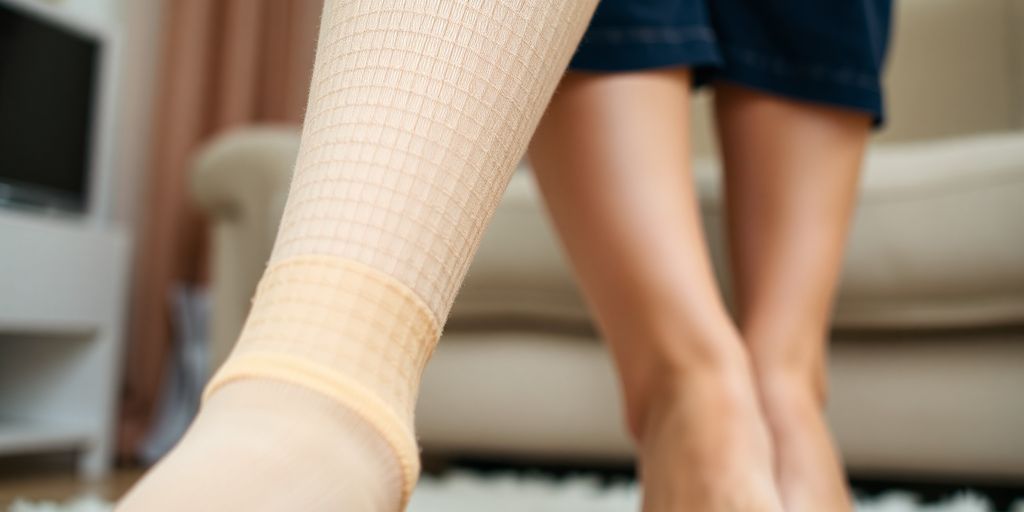Dealing with swollen feet and ankles can be a real pain, whether it's from standing all day, a medical condition, or even just the heat. Finding the right Edema compression socks can make a huge difference in how comfortable and supported your feet feel. These special socks are made to help bring down swelling and get your blood flowing better, giving your feet the relief they need. This article will go over how to pick the best Edema compression socks, how to wear and care for them, and some other things you can do to feel better.
Key Takeaways
- Edema compression socks help manage swelling from things like pregnancy or long hours on your feet.
- Pick socks with the right compression level—either moderate or firm—depending on what you need.
- Materials that breathe are super important to keep your feet comfy and dry all day long.
- Taking care of your socks, like washing them right and having a few pairs to switch between, makes them last longer and work better.
- Other ways to ease swelling include putting your feet up, staying active, and gentle foot massages.
1. Sockwell
Sockwell is a brand that often comes up when people talk about good compression socks. They're known for using merino wool, which is great because it helps keep your feet comfortable and dry. I've tried a few different brands, and I have to say, Sockwell really does feel different. They have a range of compression levels, so you can find something that works for you.
I really like that Sockwell socks don't feel like you're wearing something super medical. They have some nice designs and colors, so you can actually wear them with regular clothes without feeling like you're making a statement. Plus, the merino wool is a game-changer if you deal with sweaty feet.
Here's a quick rundown of why people seem to like them:
- Comfortable materials
- Good moisture control
- Variety of styles
Some people swear by Sockwell compression socks and say they're worth the money because they last longer and feel better than cheaper options. I've had a pair for over a year now, and they're still holding up well, so I'd say it's a pretty good investment.
2. Pro Compression
Pro Compression is another big name in the compression sock game. They're known for their bright colors and durable construction. I've had a few pairs of their socks for years, and they still hold up pretty well, even after tons of washes. Their socks are designed for athletes, but honestly, anyone can wear them for everyday swelling relief.
Here's why people like them:
- They offer a wide range of compression levels, so you can find the right fit for your needs.
- The material is moisture-wicking, which is great if your feet tend to sweat.
- They come in a ton of fun colors and patterns, so you can actually enjoy wearing them.
I remember when I first tried Pro Compression socks. I was training for a half-marathon, and my legs were constantly aching. These socks made a noticeable difference in my recovery time. I could actually walk the next day without feeling like I'd aged 50 years. It's a small thing, but it makes a big difference.
Pro Compression also offers athletic compression socks, tights, and sleeves, so you can get compression gear for all your activities. They even have compression tops! It's a one-stop shop for all things compression. If you're looking for something durable and effective, Pro Compression is worth checking out. They offer both graduated and uniform compression, so you can find the right type of compression level for your needs.
3. Cotton
Cotton compression socks are a pretty common choice, and for good reason. They're soft, breathable, and generally more affordable than some of the fancier materials out there. I remember when my grandma first started wearing compression socks, she insisted on cotton because it felt the most comfortable against her skin.
The big plus with cotton is its comfort. It's a natural fiber, so it tends to be less irritating, especially if you have sensitive skin. Plus, cotton is pretty good at absorbing moisture, which can help keep your feet dry and prevent that sweaty, uncomfortable feeling. However, that moisture absorption can also be a downside – cotton socks can stay wet for a while, which might not be ideal if you're doing a lot of physical activity or live in a humid climate. For those who need to control edema/swelling, cotton is a popular choice.
One thing to keep in mind is that cotton compression socks might not be as durable or offer as much support as some of the synthetic options. They can lose their shape and compression over time, especially after repeated washing. So, while they're great for everyday wear and comfort, you might need to replace them more often.
Here are a few things to consider when choosing cotton compression socks:
- Compression Level: Make sure you're getting the right level of compression for your needs. Talk to your doctor or a specialist if you're not sure.
- Fit: A good fit is crucial. Too tight, and they'll be uncomfortable; too loose, and they won't do their job.
- Quality: Not all cotton is created equal. Look for high-quality cotton for better comfort and durability.
4. Bamboo

Bamboo compression socks? Yeah, they're a thing, and they're pretty cool. I was skeptical at first, but after trying a pair, I get the hype. They're not just some trendy material; they actually have some solid benefits, especially if you're dealing with swelling.
Bamboo fibers are naturally breathable and moisture-wicking, which helps keep your feet dry and comfortable. This is a big deal, especially if you're wearing compression socks for extended periods. Nobody wants sweaty, itchy feet!
Here's a quick rundown of why bamboo socks might be a good choice:
- Softness: Seriously, they feel amazing against your skin.
- Eco-Friendly: Bamboo is a sustainable resource, so you can feel good about your purchase.
- Odor Resistance: Bamboo has natural antibacterial properties, which can help reduce foot odor.
I've found that bamboo socks are especially nice during warmer months. They don't feel as heavy or stifling as some other materials, and they really do seem to keep my feet drier. Plus, they're surprisingly durable. I've washed mine a bunch of times, and they still look and feel great. If you're looking for a comfortable and eco-conscious option, give bamboo a try. They might just become your new favorite compression socks for managing edema.
5. Merino Wool
Merino wool compression socks? Yeah, they're a thing, and they're pretty awesome. I never thought wool socks could be comfortable, especially for something like compression, but merino is different. It's super soft and not itchy at all, which is a huge win.
One of the best things about merino wool is that it's naturally moisture-wicking. So, even if your feet sweat, the socks help keep them dry and comfortable. Plus, it has natural odor-resistant properties, which is a nice bonus, especially if you're wearing them for long periods. I've worn merino wool socks on hikes, and they've been great at preventing blisters and keeping my feet feeling fresh.
Merino wool compression socks are a solid choice if you want something comfortable, breathable, and good for all-day wear. They might be a bit pricier than other options, but the comfort and benefits are worth it, in my opinion.
Here's a quick rundown of why I like merino wool compression socks:
- Soft and comfortable
- Moisture-wicking
- Odor-resistant
- Good for all-day wear
I've found that compression socks made from merino wool are great for travel too. They help with circulation on long flights and keep my feet from feeling tired and swollen. I usually pair them with comfortable shoes, and it makes a big difference. If you're looking for a natural and comfortable option, merino wool is definitely worth considering.
6. Nylon
Nylon is a popular choice for compression socks because of its durability and elasticity. It's a synthetic fiber that can withstand a lot of wear and tear, making it ideal for everyday use. Plus, nylon socks tend to be more affordable than some of the natural fiber options.
Nylon is great because it's easy to care for. You can throw them in the washing machine without worrying too much about them shrinking or losing their shape. However, some people find nylon less breathable than natural fibers, which can lead to sweaty feet.
Here are some things to consider when choosing nylon compression socks:
- Compression Level: Make sure you pick the right level of compression for your needs. If you're not sure, start with a lower level and work your way up.
- Fit: A good fit is essential for compression socks to work properly. Wearing compression socks too low can cause discomfort.
- Thickness: Nylon socks come in different thicknesses. Thicker socks will be warmer, while thinner socks will be more breathable.
7. Polyester

Polyester compression socks are a popular choice, and for good reason. They're known for their durability and resistance to stretching, which means they can maintain their compression level for a longer time. This makes them a reliable option if you need consistent support throughout the day.
Polyester is also pretty good at wicking away moisture, helping to keep your feet dry and comfortable. However, some people find that polyester isn't as breathable as natural fibers like cotton or merino wool. If you tend to have sweaty feet, you might want to consider socks that blend polyester with other materials.
Here's a quick rundown of the pros and cons:
- Pros:
- Durable and long-lasting
- Good moisture-wicking properties
- Maintains compression well
- Cons:
- Can feel less breathable than natural fibers
- May not be as soft against the skin
- Can sometimes retain odors if not properly cared for
I've found that polyester socks are great for activities where I need a lot of support, like long walks or standing for extended periods. They hold up well and don't lose their shape, which is a big plus. Just make sure to wash them regularly to keep them fresh.
Ultimately, the best compression sock material depends on your individual needs and preferences. If you're looking for something that's durable and provides consistent compression, polyester is definitely worth considering. Just be mindful of the breathability factor, especially if you live in a warmer climate or have feet that tend to sweat. Remember to check out compression socks to help with swelling.
Wrapping It Up
So, there you have it! Finding the right socks for swollen feet and ankles can really make a difference in your comfort. Whether you go for compression styles or something more breathable, the key is to choose what feels best for you. Remember to wear them when your feet are less swollen, and take care of them so they last longer. Plus, don’t forget about other simple tips like elevating your feet and staying active. With the right approach, you can tackle that swelling and get back to feeling like yourself again.
Frequently Asked Questions
What are edema socks?
Edema socks are special socks made to gently squeeze your feet and ankles. This pressure helps improve blood flow and stops fluid from building up, which makes swelling go down.
How do I pick the right amount of squeeze?
If your swelling is mild, socks with a moderate squeeze (15-20 mmHg) are usually good. For more serious swelling, you might need a firmer squeeze (20-30 mmHg). It's always a good idea to chat with your doctor about what's best for you.
Can I wear edema socks all day long?
Yes, you can wear them all day! The best time to put them on is first thing in the morning before your feet start to swell. This helps keep the swelling from getting worse throughout the day.
How do I take care of my edema socks?
To make your socks last longer, wash them by hand or on a gentle cycle in cold water. Don't use bleach, and let them air dry. Also, having a few pairs to switch between can help them keep their stretch and last longer.
What else can I do to help with swollen feet?
While edema socks are super helpful, you can also try lifting your feet higher than your heart, moving around regularly, and giving your feet a gentle rub. Cutting back on salty foods and drinking plenty of water can also help a lot.
When should I see a doctor about my swollen feet?
You should see a doctor if your swelling comes on suddenly and is very bad, if you feel pain or tenderness, or if you have other health issues like heart or kidney problems. Also, if you have trouble breathing or chest pain along with the swelling, get medical help right away.




Share:
Understanding Edema Compression Support: A Comprehensive Guide
Choosing the Best Lymphedema Sleeves for Comfort and Efficacy